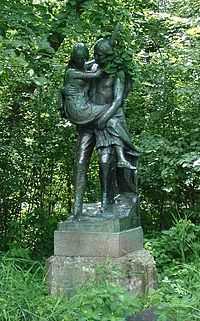Jacob Fjelde
Jacob Fjelde (1855 – 1896 ) was a Norwegian-born, American sculptor.[1]
Background
| Jacob Fjelde | |
|---|---|
 Monument to the 1st Minnesota Infantry at Gettysburg National Battlefield | |
| Born |
Jakob Henrik Gerhard Fjelde April 10, 1855 Ålesund, Norway |
| Died |
May 5, 1896 (aged 41) Minneapolis, Minnesota |
| Occupation | sculptor |
| Children | Paul Fjelde |
Jacob Fjelde was born in Ålesund, Norway. His father, a carpenter and wood carver, had moved to the United States in 1872, though Fjelde did not arrive there until about 1887. After arriving in America he settled in Minneapolis, Minnesota.[2] He was the father of sculptor Paul Fjelde and the brother of artist Pauline Fjelde. His grandsons included Ibsen scholar Rolf G. Fjelde.
Career
Fjelde is remembered as both a prolific portraitist and the creator of public monuments. One of his better known works is the one dedicated to the 1st Minnesota Infantry (1897) located at Gettysburg Battlefield where its 262 members suffered 215 casualties.[3]
The Minneapolis-St. Paul area hosts several of his major public bronze outdoor monuments. One is a Statue of Hiawatha carrying Minnehaha, based on characters from Henry Wadsworth Longfellow's poem The Song of Hiawatha. The statue was created for the Columbian Exposition in 1893 and permanently erected in 1912. Another, in Loring Park in Minneapolis, is of Norwegian violin virtuoso Ole Bull was cast in 1897, a year after Fjelde's death. The Minerva bronze sculpture is located in the downtown Minneapolis Central Library.[1]
Jacob Fjelde had first sculpted Henrik Ibsen from life in Molde, Norway during 1885. Although Ibsen disliked sitting for artists, he took a liking to the precocious young sculptor, then 26 years old, and patiently sat for the bust.[4] Among his portraits of Ibsen, several are noteworthy. One is located in Tacoma, Washington in Wright Park, another is at the North Dakota State College of Science in Wahpeton, North Dakota.[5] Another bust of Ibsen, located in the Como Park, Zoo, and Conservatory in St. Paul, Minnesota was stolen from the Park in 1981. The sculpture was recovered, restored, and reinstalled by Public Art Saint Paul in 1999.[6]
Additional reading
- Hansen, Carl G. O. My Minneapolis. (Minneapolis, MN: Standard Press, 1956) pp. 159-165 and pp. 169-170.
Gallery
-

Ole Bull statue at Loring Park
-

Hiawatha and Minnehaha statue at Minnehaha Park
-

John H. Stevens statue at Minnehaha Park. Sculptor Johannes Gelert worked from drawings made by Fjelde.
References
- ↑ 1.0 1.1 Harris, Moira F., Monumental Minnesota: A Guide to Outdoor Sculpture, Pogo Press, 1992, pg. 6
- ↑ Proske, Beatrice Gilman, Brookgreen Gardens Sculpture, Brookgreen Gardens, South Carolina, 1943, pg. 355
- ↑ Hawthorne, Frederick W., Gettysburg: Stories of Men and Monuments, The Association of Licensed Battlefield Guides, 1988, pg. 81
- ↑ Templeton, Joan About the bust of Henrik Ibsen (Ibsen Society of America Home Page)
- ↑ Collin, Andrea Winkjer Prairie Arts (North Dakota Council on the Arts. Issue No. 08-3. September, October, November, December 2008)
- ↑ Public Art Saint Paul Henrik Ibsen bust at Como Park
External links
| Wikimedia Commons has media related to Jacob Fjelde. |
- Sculptor Jakob Fjelde
- Marie Dreis Scheffer bust
- Ole Bull statue at Loring Park
- Hiawatha and Minnehaha at MNOPEDIA
- Hiawatha and Minnehaha at Minnehaha Falls
- Henrik Ibsen bust at Wright Park in Tacoma
- Jakob Hendrik Gerhard Fjelde with his siblings
- "An Artist's Odyssey" in Twin Cities magazine, March 1986
- John H. Stevens statue by Johannes Gelert and Jacob Fjelde
- Minnesota- 1st Infantry Memorial at Gettysburg Nat'l Military Park
Online book
Burton Hall at the University of Minnesota
- The History of Burton Hall
- Spandrel figures by Jacob Fjelde in the interior of Burton Hall
Hennepin County Library
- Minerva statue outside of Minneapolis Central Library at 10th and Hennepin
- Minerva statue inside Minneapolis Central Library at 300 Nicollet Mall
Minnesota Historical Society
- Ole Bull statue at Loring Park
- Henrik Ibsen bust at Como Park
- Hiawatha and Minnehaha statue at Minnehaha Park
|